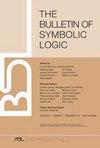构造几何与平行公设
IF 1.1
3区 数学
Q1 LOGIC
引用次数: 12
摘要
欧几里得几何包括直线和罗盘结构以及对这些结构的结果的推理。我们证明欧几里得几何可以只用直觉逻辑来发展。我们考虑欧几里得平行公设的三种版本:欧几里得在他的公设5中自己的表述;Playfair 1795年的版本,以及我们称之为强平行假设的新版本。不同之处在于,欧几里得的版本和新版本都断言两条线相交的点存在,而普莱费尔的版本没有断言存在。经典地,欧几里得几何模型(直线和罗盘)是欧几里得场上的平面。在构造欧几里得几何中,我们证明了一个类似的定理,通过说明如何定义加法和乘法,而不需要对参数的符号进行区分。在直觉逻辑中,欧几里得场有两种可能的定义,它们对应于平行公理的不同版本。在本文中,我们完全解决了三个版本的并行公设之间的含义问题:强并行公设容易隐含欧几里得5,事实上欧几里得5也隐含强并行公设,虽然证明很长,取决于欧几里得5足以从几何上定义乘法的验证。我们证明了Playfair并不意味着欧几里得5,我们也给出了一些其他的独立性结果。我们的独立性证明是在不讨论其他几何公理的确切选择的情况下给出的;我们所需要的只是能够解释欧几里得场论中的几何公理。这些证明使用基于精心构造的实值函数环的欧几里得场论的克里普克模型。本文章由计算机程序翻译,如有差异,请以英文原文为准。
Constructive Geometry and the Parallel postulate
Euclidean geometry consists of straightedge-and-compass constructions and reasoning about the results of those constructions. We show that Euclidean geometry can be developed using only intuitionistic logic. We consider three versions of Euclid's parallel postulate: Euclid's own formulation in his Postulate 5; Playfair's 1795 version, and a new version we call the strong parallel postulate. These differ in that Euclid's version and the new version both assert the existence of a point where two lines meet, while Playfair's version makes no existence assertion. Classically, the models of Euclidean (straightedge-and-compass) geometry are planes over Euclidean fields. We prove a similar theorem for constructive Euclidean geometry, by showing how to define addition and multiplication without a case distinction about the sign of the arguments. With intuitionistic logic, there are two possible definitions of Euclidean fields, which turn out to correspond to the different versions of the parallel axiom. In this paper, we completely settle the questions about implications between the three versions of the parallel postulate: the strong parallel postulate easily implies Euclid 5, and in fact Euclid 5 also implies the strong parallel postulate, although the proof is lengthy, depending on the verification that Euclid 5 suffices to define multiplication geometrically. We show that Playfair does not imply Euclid 5, and we also give some other independence results. Our independence proofs are given without discussing the exact choice of the other axioms of geometry; all we need is that one can interpret the geometric axioms in Euclidean field theory. The proofs use Kripke models of Euclidean field theories based on carefully constructed rings of real-valued functions.
求助全文
通过发布文献求助,成功后即可免费获取论文全文。
去求助
来源期刊
CiteScore
0.60
自引率
0.00%
发文量
32
审稿时长
>12 weeks
期刊介绍:
The Bulletin of Symbolic Logic was established in 1995 by the Association for Symbolic Logic to provide a journal of high standards that would be both accessible and of interest to as wide an audience as possible. It is designed to cover all areas within the purview of the ASL: mathematical logic and its applications, philosophical and non-classical logic and its applications, history and philosophy of logic, and philosophy and methodology of mathematics.

 求助内容:
求助内容: 应助结果提醒方式:
应助结果提醒方式:


